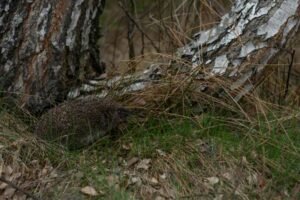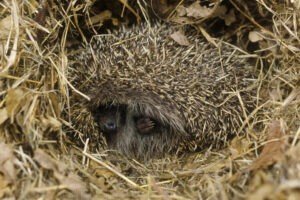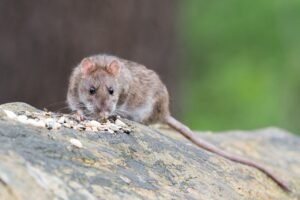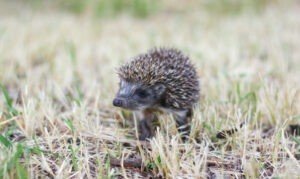If you want to attract hedgehogs to your garden, you will need to provide an accessible habitat that is friendly to the species. This includes an emphasis on providing adequate shelter, food, and safety measures to a garden space suitable for hedgehog feeding, hibernation, and nesting behaviours.
I’ve often wondered how to attract hedgehogs to my garden, given it seems like a perfectly fine place for the small birds and insects in my area. When I recently planted a few leafy plants and flowers around my garden’s edges, I also wondered if an ideal hedgehog environment could be far behind.
Well, it turns out that hedgehogs would indeed like this kind of environment — but keeping a garden that actually attracts them requires a bit more effort and knowledge. So to help you out with bringing these spiny creatures around to your yard, here’s what I’ve found works best.
HABITAT
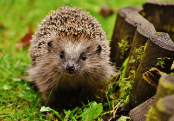
There are a few things to know about hedgehogs when trying to attract them to your garden. The first thing to know is that hedgehogs live up to their name — they like living under hedges, bushes, and the brush that surrounds woodlands and fields.
The next thing to know is that you will want to make your garden accessible to hedgehogs and patterned somewhat after the type of underbrush environment with which they are familiar.
This includes understanding hedgehog territorial behavior, modifying your garden’s perimeter, and understanding hedgehog-friendly garden plants.
RANGE
Hedgehogs are highly mobile creatures with fairly large territories. A nocturnal creature, hedgehogs can wander up to 2 or 3 kilometers each night, and their range can reach 10 or 20 hectares in size.
This is great for hedgehog-friendly environments in the countryside — but in the context of urban or suburban gardens, this means that hedgehogs will need to be able to travel a lot more than the length of a single backyard.
For this reason, it may be a good idea to coordinate with your neighbours about making your gardens collectively accessible to hedgehogs. These fence openings, ramps, and stairs are conducive to hedgehog travel and are known as ” hedgehog highways “.
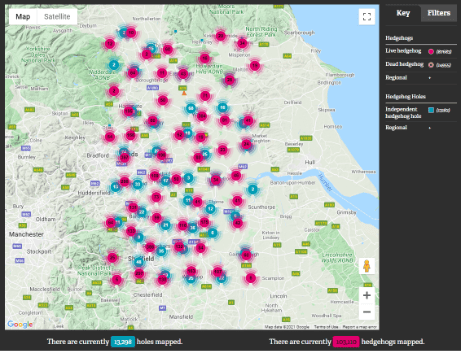
With such coordination, individual hedgehogs will have plenty of territory to cover. In addition to this, you can also do research to see if there is a hedgehog population in your area.
The British Hedgehog Preservation Society and the People’s Trust for Endangered Species (PTES), for example, offer an interactive map known as “The Big Hedgehog Map” — listing sightings of dead hedgehogs, living hedgehogs, and man-made “hedgehog holes” (species-friendly openings).
ACCESSIBILITY
To attract hedgehogs to your garden, you will want to be sure to include a few hedgehog holes. Some 13 by 13-centimeter holes made into doorway-arch shapes (cut out from the bottom of your wooden perimeter fence ) will make your garden hedgehog-accessible.
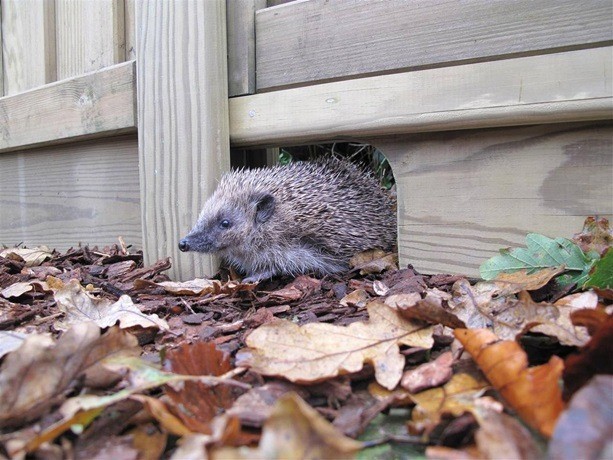
Alternately, you can use a pipe, that when cut in half, gives you an opening radius of 13 centimeters. This section of pipe can be placed under a section of chain link fence (or covering a hole dug under a wooden fence).
Hedgehogs may travel between 4 or 5 gardens a night. If a hedgehog highway is established with easily accessible openings like these, they will have no problem navigating though.
If you have a pond, set up a 10-centimeter wide (or so) wooden plank so that hedgehogs can escape it. Using rocks to weigh down one end of the plank in the water, and more rocks to lift the edge outside, create a ramp leading out of the pond.
Be sure to cut some grooves perpendicular to the length of the plank to have it act as a “ladder”. Hedgehogs can swim, but not for extended periods of time — making a ramp will help them out of trouble.
PLANTS
Your garden plants — especially flowers, and of course, hedges — will provide hedgehogs with cover to travel, rest, nest, and breed. You will want to choose native flowering plants like cornflower, poppies, red campion, oxeye daisy, common knapweed, and wild white clover.
Hedges like hawthorn, goat willow, and dogwood shrubs would be excellent hedgehog-friendly additions to a garden. Field maple hedges, beech hedges and hazel hedges are all good hedge options.
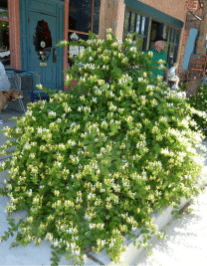
The plants you use in your garden can not only provide shelter for hedgehogs — but also food, albeit indirectly. Blackthorn, dog rose, honeysuckle, and hawthorn are examples of plants that provide an excellent food source for moth caterpillars, which in turn are what hedgehogs enjoy.
You can keep your garden tidy to some degree, but you might want to designate an area where you’re not trimming back your plants so much. This will provide a better place for insects and larvae to flourish (hedgehogs particularly like to eat larvae, worms, and caterpillars) and will provide a go-to place for hedgehog cover.
In addition to various flower and hedge formations, compost heaps, piles of leaves, and log piles can also provide good hedgehog cover. Provide spaces large enough for hedgehogs to pass through (especially in log piles) and moderately line these places with dry grass to provide an underbrush-like environment.
WAYS TO ATTRACT HEDGEHOGS
If you are still wondering about “how to attract hedgehogs to my garden”, the answer is not too difficult — hedgehogs are partial to the right types of food, shelter, and comforts as other creatures.
I’ve found that providing hedgehogs with good natural food sources, some supplementary food sources, and a good home (natural or man-made) is enough to keep them coming to my garden area.
FOOD
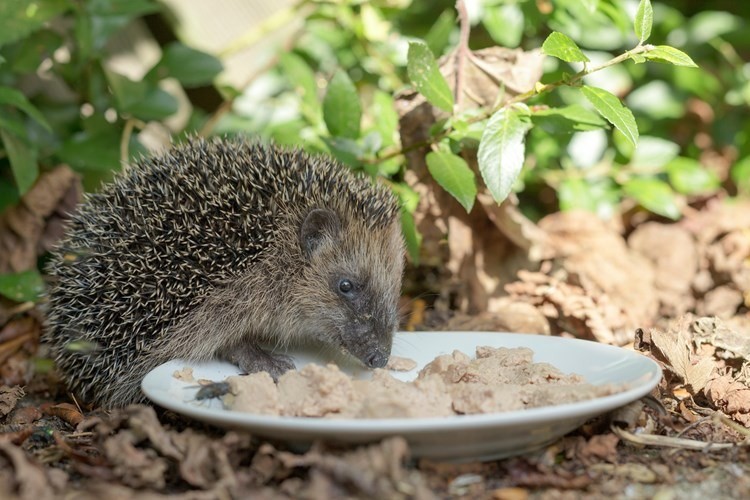
A hedgehog’s natural diet consists mainly of worms, slugs, ground beetles, pill millipedes, black millipedes, and caterpillars — and may contain some plant (i.e fruit) and fungal matter.
These foods can occur naturally by providing a decent environment for them in the spring and summer seasons. Compost piles, leaf piles, and certain types of plants can assist in flourishing these species — as does any bit of soil that is moist and rich enough.
During the drier and colder seasons (fall and winter), hedgehogs may need some assistance with food. In this case, you might consider feeding them some cat biscuits (no fish), dried mealworms, or wet dog food (no gravy) served in a tray.
To keep this tray out of the reach of pets and other animals, place the tray of food under an upside-down clear plastic container large enough to fit it and a few hedgehogs. We have written an article, what are ground feeders, which explains ground feeders in more detail.
Keeping some rocks on top, cut a hole in the wall of the container (that is flush to the ground) large enough (about 12 centimeters) to provide a “doorway” for the hedgehog. This will help keep larger animals (such as dogs or cats) out.
Remember that this is only a supplemental food source — and adding too much food can be detrimental to hedgehog health. If you have neighbours who are sheltering hedgehogs in their gardens, get to know if any of them are feeding hedgehogs as well.
Supplemental foods may also attract rats or mice. If you feel that you do not have to put extra food out, don’t do it. If nothing else, provide a shallow tray of water so that the hedgehog can have something to drink during dry nights.
HOUSING

You can easily provide hedgehog housing by placing a flat bit of rock on top of a few bricks. Stack the bricks high enough so that a hedgehog can get inside (and other animals can’t). Put a brick or two on top, and line the inside with some dried leaves, grass, or straw.
If you would prefer, you build a more complex hedgehog home or use a store bought home (these are found online or in gardening stores). Whatever you choose, be sure to line the home with some soft organic materials for nesting purposes — and face the opening of the home southward.
Hedgehogs also build their own nests — and usually, the more natural you can make their accommodations, the better. This is where leaf piles, log piles, and generally denser patches of hedgerows and underbrush can come in handy.
If your thinking of purchasing a hedgehog house, I strongly recommend to read our extensive article – Hedgehog House Best Buys
ATMOSPHERE AND SAFETY
Hedgehogs need relatively quiet places to live and nest — especially during their hibernation period from around November to March. If you have barking dogs, high traffic, construction work, or movements of a lot of people, hedgehogs may get anxious and leave quickly.
Try to provide an atmosphere of relative calm — or better yet, natural environmental sounds like birds chirping or insects buzzing. The more natural life you have in your garden, the more likely you will attract hedgehogs.
Also, do not interrupt or bother hibernating hedgehogs. They are true hibernating creatures that reduce their body temperature and conserve energy in a dormant state. Let them be.
SAFETY FROM HUMANS
To keep your hedgehogs safe, get into the habit of checking for them before you strim your hedges or mow the lawn. Keep your garden free of netting or any other obstructive objects. Make sure you check for hedgehogs before lighting bonfires or clearing areas of brush. If you have babies or small children, only allow them to see the hedgehog under adult supervision.
Hedgehogs are nocturnal and only come out at night. Generally, any hedgehog out during the day is probably in trouble and will need to be picked up and taken to a wildlife rescue centre.
Hedgehog Fact Sheet | Tiggywinkles
If you see a hedgehog out during the day or appearing otherwise sick or injured, call the Royal Society for the Prevention of Cruelty to Animals ( RSPCA ) at 0300 1234 999.
SAFETY FROM OTHER ANIMALS

If you are a dog owner, try to keep your dog indoors — or at least away from your garden — except for times when you are walking it and it is on a leash. Dogs can be curious or aggressive around hedgehogs, and this can lead to injuries to both animals. Keep your dog away from any place you know a hedgehog is.
Cats are generally less aggressive toward hedgehogs. They will inspect them and typically leave them alone. If you are not sure of your cat’s behavior, however, use some common sense and keep them away as well.
CHEMICAL USE
Never use slug pellets, other pesticides, or herbicides around hedgehogs. They are toxic to the animals and will not benefit them or their food supply.
If you want to reduce certain insect populations, look for natural ways to deal with them (like ladybirds for aphids or dragonflies for mosquitoes, for example) and consider companion planting. And remember, hedgehogs love eating bugs too!
HEDGEHOG DECLINE
Surely, attracting hedgehogs to your garden doesn’t need a raison d’etre — they’re cute, curious little creatures that can make for an interesting garden encounter or good watching from your kitchen window.

But recent interest in hedgehogs might stem from a trend in the overall declining hedgehog population, certainly over the course of the last century.
According to a 2011 study released by the British Hedgehog Preservation Society and the PTES, the estimated hedgehog population in Britain was about 30 million in the 1950s. The report also estimated the population in 2011 to be at around 1.5 million — with 0.31 million in Scotland, 1.1 million in England, and 0.145 million in Wales.
The same two organizations also suggested in a 2018 study that the hedgehog population had declined in rural areas (based on recorded incidents of road kills) by half in a period from 2002 to 2017. This was attributed to habitat loss, loss of food (such as larvae and worms) on farmland, and increased exposure to dangerous roadways and natural predators.
British hedgehogs are now officially classified as vulnerable to extinction
https://www.britishhedgehogs.org.uk/
However, the study also mentioned that from 2007 to 2016, the number of hedgehogs detected in urban areas (primarily gardens) had increased steadily, to 20 percent over the baseline year of 2009. These numbers could be the result of the addition of the hedgehog to the UK’s Biodiversity Action Plan (BAP) protection list since 2007.
This seems like encouraging news, as far as urban hedgehog populations are concerned. The overall hedgehog decline and burgeoning revival is yet another reason to take interest in making your garden hedgehog-friendly.
CONCLUSION
I’ve certainly learned how to attract hedgehogs to my garden with a little trial and error. What I’ve found is that, essentially, hedgehogs do not want an environment too different than many other wild animals. They enjoy the comfort of substantial vegetation, plenty of good food to eat, and a relatively quiet place to drink water and rest.
If you are considering making your garden welcoming to hedgehogs, I would suggest making the accommodations as such. Remember to coordinate with your neighbors for such a task, and you too can welcome hedgehogs to your garden.


